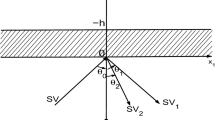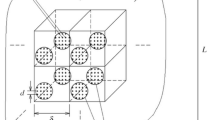Abstract
The Maxwell equations for a composite two-component laminated material with a periodic structure in the field of a time-harmonic source acting along the layers are considered. Two-scale homogenization of the equations is performed with allowance for complex conductivity of interfacial layers and their thickness. The boundary-value problem for systems of differential equations with boundary conditions is reduced to a problem in a weakly variational formulation. Unique solvability of the problem is established. The case of low frequencies of interfacial currents of different intensities with allowance for the frequency-dependent wave length and skin layer length is analyzed. Macro-equations are derived, and effective material constants are determined, such as the dielectric permittivity, magnetic permeability, and electrical conductivities. Conditions at which the effective parameters depend on interfacial currents are described. It is found that the effective dielectric permittivity can be negative at specially chosen parameters of interfacial layers if it is determined on the basis of the effective wave number.
Similar content being viewed by others
References
Y. Amirat and V. V. Shelukhin, “Homogenization of Time Harmonic Maxwell Equations: The Effect of Interfacial Currents,” Math. Methods Appl. Sci. 40 (8), 3140–3162 (2017).
C. Tournassat, Y. Chapron, P. Leroy, et al., “Comparison of Molecular Dynamics Simulations with Triple Layer and Modified Gouy-Chapman Models in a 0.1 M NaCl-Montmorillonite System,” J. Colloid Interface Sci. 339, 533–541 (2009).
Yu. V. Bludov, A. Ferreira, N. M. R. Peres, and M. I. Vasilevskiy, “A Primer on Surface Plasmon-Polaritons in Grafene,” Int. J. Modern Phys. B 27 (10), 1341001 (2013).
G. Kristensson, “Homogenization of Corrugated Interfaces in Electromagnetics,” Progr. Electromag. Res. 55, 1–31 (2005).
V. V. Shelukhin and S. A. Terentev, “Frequency Dispersion of Dielectric Permittivity and Electric Conductivity of Rocks via Two-Scale Homogenization of the Maxwell Equations,” Progr. Electromag. Res. B 14, 175–202 (2009).
V. V. Shelukhin and S. A. Terent’ev, “Homogenization of Maxwell Equations and Maxwell-Wagner Dispersion,” Dokl. Akad. Nauk, 424 (3), 402–406 (2009).
N. Wellander, “Homogenization of the Maxwell Equations: Case 2. Nonlinear Conductivity,” Appl. Math. 47 (3), 255–283 (2002).
A. N. Lagarkov, V. N. Kisel, and V. N. Semenenko, “Wide-Angle Absorption by the use of a Metamaterial Plate,” Progr. Electromag. Res. Lett. 1, 35–44 (2008).
Y. Amirat and V. V. Shelukhin, “Homogenization of Time Harmonic Maxwell Equations and the Frequency Dispersion Effect,” J. Math. Pures Appl. 95, 420–443 (2011).
L. D. Landau and E. M. Lifshits, Course of Theoretical Physics, Vol. 8: Electrodynamics of Continuous Media (Fizmatlit, Moscow, 2005; Pergamon, New York, 1984).
I. C. Bourg and G. Sposito, “Molecular Dynamics Simulations of the Electrical Double Layer on Smectite Surfaces Contacting Concentrated Mixed Electrolyte (NaCl-CaCl2) Solutions,” J. Colloid Interface Sci. 360, 701–715 (2011).
G. Nguetseng, “A General Convergence Result for a Functional Related to the Theory of Homogenization,” SIAM J. Math. Anal. 20 (3), 608–623 (1989).
K. Sarabandi and F. T. Ulaby, “Techniques for Measuring the Dielectric Constant of Thin Materials,” IEEE Trans. Instrum. Measur. 4, 631–636 (1988).
A. H. Boughriet, C. Legrand, and A. Chapoton, “Non-Iterative Stable Transmission/Reflection Method for Low-Loss Material Complex Permittivity Determination,” IEEE Trans. Microwave Theory Methods 45 (1), 52–57 (1997).
W. Brown, Jr., Dielectrics (West Berlin, 1956).
D. R. Smith, W. J. Padilla, D. C. Vier, et al., “Composite Medium with Simultaneously Negative Permeability and Permittivity,” Phys. Rev. Lett. 4 (18), 4184–4187 (2000).
Author information
Authors and Affiliations
Corresponding author
Additional information
Original Russian Text © Y. Amirat, V.V. Shelukhin.
Translated from Prikladnaya Mekhanika i Tekhnicheskaya Fizika, Vol. 60, No. 4, pp. 3–20, July–August, 2019.
This work was supported by the Government of the Russian Federation (Grant No. 14.W03.31.0002).
Rights and permissions
About this article
Cite this article
Amirat, Y., Shelukhin, V.V. Homogenization of Harmonic Maxwell Equations with Allowance for Interfacial Surface Currents: Layered Structure. J Appl Mech Tech Phy 60, 593–607 (2019). https://doi.org/10.1134/S0021894419040011
Received:
Revised:
Accepted:
Published:
Issue Date:
DOI: https://doi.org/10.1134/S0021894419040011




